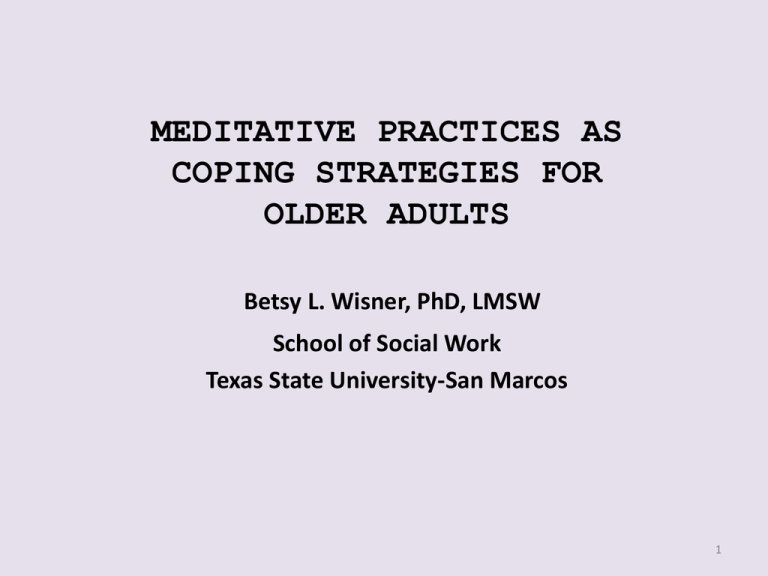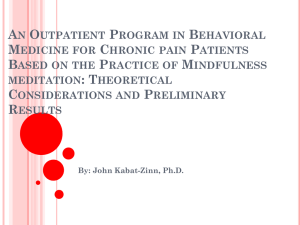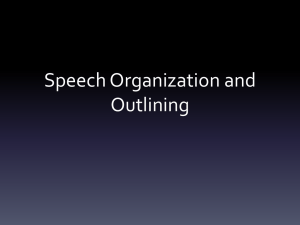meditative practices as coping strategies for older adults
advertisement

MEDITATIVE PRACTICES AS COPING STRATEGIES FOR OLDER ADULTS Betsy L. Wisner, PhD, LMSW School of Social Work Texas State University-San Marcos 1 We Will Explore • Meditative Practices Defined and Identified • Benefits for older adults • Experiential Exercise. 2 Meditative Practices Defined • A diverse set of practices that typically involve spending a period of time relaxing the body and calming the mind • Mind-Body Practices • The National Center for Complementary and Alternative Medicine (NCCAM) • These practices are often used along with conventional medicine • http://nccam.nih.gov/. 3 Meditative Practices Identified • Meditation • Yoga • Qigong and Tai Chi Chuan. 4 Meditation • Family of techniques • Particular postures • Open and nonjudgmental attitude • Two main branches of meditation: - Mindfulness meditation - Concentration meditation. 5 Mindfulness Meditation • • • • • • Present-moment awareness Acceptance Non-judgmental Non-discursive Sustained over time Jon Kabat-Zinn and his colleagues – – – – University of Massachusetts Medical Center The Stress Reduction Clinic Mindfulness Based Stress Reduction [MBSR] Meditation plus yoga. 6 Concentration meditation • Repeated focus on a particular word, phrase (e.g., a mantra) or object • Transcendental Meditation (TM) – Requires a certified teacher – The use of a personal mantra – Payment of a fee for instruction • Herbert Benson’s Relaxation Response Method – – – – Self chosen personal mantra Mantra may be a word, sound, or even a short prayer Does not require a certified teacher Can be learned through personal guidance or the use of printed materials. 7 Meditation: Possible Adaptations for Older Adults • Preconceptions • Posture • Assess hearing. 8 Potential Benefits of Meditation • • • • • • • • Reduces stress and improves quality of life Improves self-regulation Improves cognition (e.g., attention, focus) Relieves anxiety and depression Relieves symptoms of chronic pain Relieves asthma symptoms Reduces blood pressure Reduces insomnia. 9 Yoga Typically combines: • Physical postures (asana) • Breathing techniques • Meditation or relaxation • Many styles of yoga. 10 Yoga: Possible Adaptations for Older Adults • • • • • • Avoid background music Avoid incense or candles Modify asanas (posture and time in position) Use props Use chairs Bonura (2011). 11 Potential Benefits of Yoga • • • • Reduces stress and improves quality of life Reduces blood pressure Relieves chronic pain Relieves chronic obstructive pulmonary disease • Improves immune function • Reduces insomnia • Relieves depression. 12 Qigong • • • • • Ancient Chinese discipline Gentle physical movements Mental focus Deep breathing http://nccam.nih.gov/video/taichidvd-3 13 Tai Chi Chuan • • • • • • • • A form of Qigong Originated in China as a martial art Internal martial art Moving meditation Focused awareness Coordinating the breath with the movement Movements performed in a standard routine http://nccam.nih.gov/video/taichidvd-4 14 Tai Chi Chuan: Possible Adaptations for Older Adults • • • • Simplify movements Modify the routines (from 108 postures to 8) Use of chair Assess hearing and vision. 15 Potential Benefits of Tai Chi • • • • • Reduces stress and improves quality of life Reduces bone loss in postmenopausal women Relieves anxiety and depression Reduces pain (e.g., fibromyalgia, arthritis) Improves balance, strength, flexibility, and coordination. 16 Choosing the Best Practice for Your Population • Mindfulness meditation – May allow for enhanced cognitive control – To teach an on-going meditation practice – Use of media and CD’s • Mantra meditation – May be easier for novice meditators – Some mantra meditation practices require no expert instruction and do not require an on-going meditation practice to teach the skill • Yoga, Qigong, Tai Chi Chuan – Movement plus meditation. 17 Chime and Contemplation • Chime and Contemplation. 18 Questions? 19 Selected Resources • • • • • • • • • • • • • • • • • Adler, P.A., & Roberts, B.L. (2006). The use of tai chi to improve health in older adults. Orthopaedic Nursing. ;25(2):122–126. Barnes, P.M., Bloom, B., & Nahin, R. (2008). Complementary and alternative medicine use among adults and children: United States, 2007 (299 KB PDF). CDC National Health Statistics Report #12. Bonura, K.B. (2011). The psychological benefits of yoga practice for older adults: Evidence and guidelines. International Journal of Yoga Therapy, 21, 129-142. Bonadonna, R. (2003). Meditation’s impact on chronic illness. Holistic Nursing Practice. 17(6), 309–319). Committee for Stress Free Schools, NIH-Funded Scientific Research on Transcendental Meditation; http://www.tmeducation.org/research-nationalinstitutes-of-health. Davidson R.J., Kabat-Zinn J., & Schumacher J, et al. (2003). Alterations in brain and immune function produced by mindfulness meditation. Psychosomatic Medicine. 65(4), 564–570. Farrell, S.J., Ross, A.D., & Sehgal, K.V. (1999).Eastern movement therapies. Physical Medicine and Rehabilitation Clinics of North America. 10(3):617–629. Jha, A.P., Krompinger J., & Baime M.J. (2007). Mindfulness training modifies subsystems of attention. Cognitive, Affective & Behavioral Neuroscience. 7(2):109–119. Lan, C., Lai, J.S., & Chen, S.Y. (2002). Tai chi chuan: an ancient wisdom on exercise and health promotion. Sports Medicine. 32(4): 217–224. Lipton L. (2008).Using yoga to treat disease: an evidence-based review. Journal of the American Academy of Physician Assistants. 21(2), 4–41. National Center for Complementary and Alternative Medicine (2005). Expanding Horizons of Health Care: Strategic Plan 2005–2009. Bethesda, MD: National Center for Complementary and Alternative Medicine; NIH publication no. 04–5568. National Center for Complementary and Alternative Medicine. Mind-Body Medicine: An Overview. National Center for Complementary and Alternative Medicine Web site. http://nccam.nih.gov/ Oken, B.S., Zajdel, D., & Kishiyama S., et al. (2006). Randomized, controlled, six-month trial of yoga in healthy seniors: effects on cognition and quality of life. Alternative Therapies in Health and Medicine. 12(1):40–47. Ospina, M.B., Bond T.K., & Karkhaneh, M. et al. (2007). Meditation Practices for Health: State of the Research (3MB PDF). Evidence Report/Technology Assessment no. 155. Rockville, MD: Agency for Healthcare Research and Quality. AHRQ publication no. 07–E010. Raub, J.A. (2002). Psychophysiologic effects of Hatha yoga on musculoskeletal and cardiopulmonary function: a literature review. The Journal of Alternative and Complementary Medicine. 8(6), 797–812. Wang C., Collet J.P., & Lau J. (2004). The effect of tai chi on health outcomes in patients with chronic conditions: a systemic review. Archives of Internal Medicine. 164(5), 493–501. Yang K. (2007). A review of yoga programs for four leading risk factors of chronic diseases. Evidence-Based Complementary and Alternative Medicine. 4(4), 487–491. 20 MEDITATIVE PRACTICES AS COPING STRATEGIES FOR OLDER ADULTS Betsy L. Wisner, PhD, LMSW bw30@txstate.edu School of Social Work Texas State University-San Marcos San Marcos, Texas 78666 www.txstate.edu May 7, 2012 The Seventh Annual University of Maine Geriatrics Colloquium Complementary and Alternative Therapies for Older Adults Point Lookout Resort and Conference Center Northport, Maine 21








